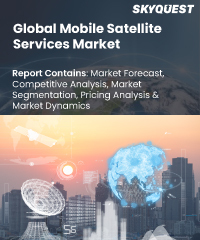
Report ID: SQMIG45H2036

Report ID:
SQMIG45H2036 |
Region:
Global |
Published Date: March, 2024
Pages:
197
|
Tables:
63 |
Figures:
75
Mobile Satellite Services (MSS) Market size was valued at USD 5.6 Billion in 2023 and is poised to grow from USD 5.99 Billion in 2024 to USD 10.21 Billion by 2032, growing at a CAGR of 6.90% during the forecast period (2025-2032).
The application of satellite communication in both the IoT and the emergency management areas in the developed regions is predicted to be the key driver for the studied market during the forecast period. Mobile satellite applications can also find application in other areas such as telecommunication, weather forecasting, navigation, military intelligence and space exploration. Furthermore, linking up 5G mobile networks with the next-generation satellite features gives mobile satellite companies a chance to take a significant part in the 5G community. Up to recently, the MSS bands were separated from the ones for the terrestrial cellular; as the mobile user either required a dual band-frequency handset or two distinct handsets. Nonetheless in the past decade, several system planners suggested that the MSSfrequency bands may be used to serve terrestrial cellular and satellite communications hence the handsets be simplified and the user always through one service provider.
The earth-based cellular network supporting this operating mode is called the ancillary terrestrial component (ATC). Although this will add more loads on already allocated frequency and will need special safeguards to protect GPS operations in the adjacent slots, the concept has been permitted conditionally in the United States for the deployment of new integrated satellite and terrestrial networks using standard devices with form factors like current PCS/Cellular devices. A convergence is noted in the emerging wireless and mobile satellite services.
The concept of interoperability can be defined as the ability of the different information systems, devices, and applications to connect seamlessly, trans-organizational and intra-organizational boundaries, to access, share, and cooperatively use the data amongst the stakeholders. Data exchange architectures and standards provide a mechanism to share the relevant data effectively and securely across all applicable settings and with all necessary stakeholders (including the person whose information is being shared).
Our industry expert will work with you to provide you with customized data in a short amount of time.
REQUEST FREE CUSTOMIZATIONWant to customize this report? This report can be personalized according to your needs. Our analysts and industry experts will work directly with you to understand your requirements and provide you with customized data in a short amount of time. We offer $1000 worth of FREE customization at the time of purchase.

Report ID: SQMIG45H2036